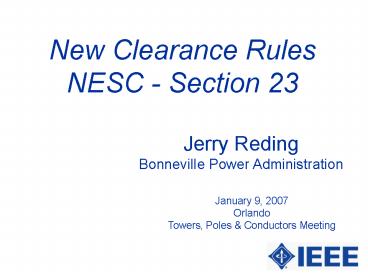TP PowerPoint PPT Presentation
1 / 16
Title: TP
1
New Clearance Rules NESC - Section 23
Jerry Reding Bonneville Power Administration
January 9, 2007 Orlando Towers, Poles
Conductors Meeting
2
Summary Clearances
- Section 23 Clearances
- Background and basis for changes
- What has changed in 2007 Edition
- Rational for changes
- What has not changed in 2007 Edition
- Potential future changes beyond 2007
3
Clearances Section 23
- Electrical clearances for safety
- Other Activities (Ground, roads, rails, etc 231
232) - Other wires on structures (233 235)
- Other Installations (Buildings, Bridges, etc 234)
- Qualified electrical worker clearances (236
237) - Clearance from other facilities
(Communication, brackets, etc 238 239)
4
Wire Sags Section 23
- For wire location through out Section 23
- Vertical clearance largest final sag.
- 1) 50 C, no wind displacement
- 2) Maximum wire temperature, no wind
- 3) 0 C, no wind, radial ice thickness as
specified in Rule 250B
5
Final Sag Rule 250B
- Wire final sag includes inelastic stretch from
(which ever is greater) - Combined ice and wind loading plus constant (k)
- Long-term creep under everyday tensions
- Final sag dependent on ice and wind loading for
all three cases not just ice case (3) - Changes in Rule 250B directly impacts final sags
hence clearance calculations
6
Final Sag Rule 250B
ice (Table 250-1)
wind force (Table 250-1)
weight
wire
constant k (Table 251-1)
total load
_at_ specified temperature (Table 251-1)
7
Final Sag Rule 250B
- Subcommittee 5 has been considering (eventually)
changing Rule 250B - Previously three loading districts light,
medium, and heavy loading - New Rule 250D ice map is ultimate ice which
generally increases ice thickness - Final sags potentially increased as clearances
are referenced back to Rule 250 ice map(s)
8
Final Sag Rule 250B
9
Final Sag Rule 250B
- Combined ice wind
- 50-Year freezing rain with 3-second gust
- More maps to follow
- Loading is complex
- Ice is generally heavier
10
New Rule 250B Issues
- Ice map moves from working ice to ultimate ice
(ASCE) - Impacts clearances
- Increases final sag
- Increase iced sags
- Experience does not justify increase in clearance
calculations - Referencing Rule 250 from Section 23 complicates
this Edition and future changes
11
Changes In Section 23
- Added Clearance Zone map and wire loading tables
to Section 23 - Clearance Zone emulates Rule 250B Loading
District map (Figure 230-1) - Wire loading tables (Table 230-1 230-2)
emulates Table 250-1 250-2 - Separates Section 23 from Section 25
12
Changes In Section 23
Figure 230-1 - Clearance zone map of the United
States
13
Rational for Changes
- Separates Section 23 and Section 25
- Section 23 specifies loadings for clearances
- Section 25 specifies loadings for wire and
structure strength - Ensures Subcommittee 4 controls clearances
- Ensures Subcommittee 5 controls strengths
- Facilitates future potential changes without
problematic conflicts nor unintended impacts
14
Not Changed Section 23
- Retention of loading districts and component
loading in Section 23 - Essentially NO CHANGE for clearances
- New Appendix B provides background and rational
for new Clearance Zones
15
Potential Future Changes
- Additive k constant serves no purpose in
Section 23 - Used for calculating tensions by effectively
increasing wind from 4 lbs/sq ft to 8 lbs/sq ft - Separates wire tension from vertical and
horizontal loads applied to structure attachments - New Clearance Zones could specify wind directly
for clearances and eliminate k - Simplify clearance rules and reduce confusion in
Code for calculating clearances
16
Thank You
- Q/A

